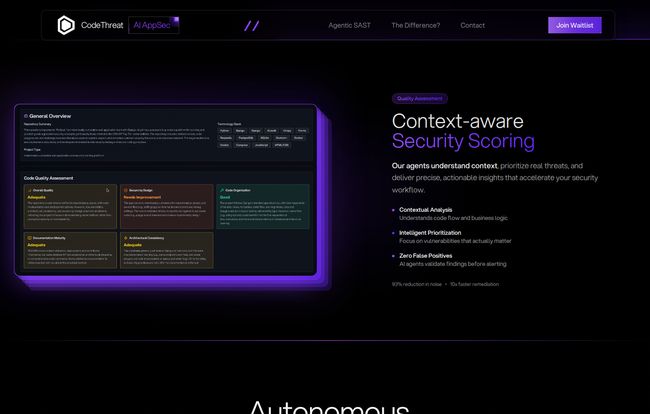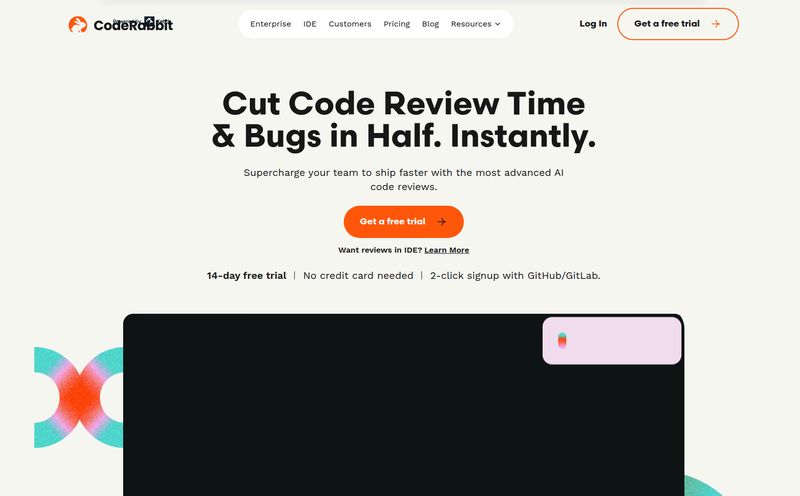As someone who’s been in the SEO and dev space for years, I have a complicated relationship with security tools. Specifically, Static Application Security Testing, or SAST, tools. They’re like that one friend who means well but has absolutely no social filter. They point out every tiny flaw, real or imagined, until you just want to tune them out completely.
The noise. The endless alerts. The wild goose chases for vulnerabilities that turn out to be nothing. We’ve all been there, burning hours of developer time on what amounts to digital busywork. It’s the classic friction point where the security team’s mandate clashes with the development team’s need to, you know, actually ship code. For a long time, it just felt like a necessary evil.
So, when I heard about CodeThreat and its promise of an “Autonomous AppSec Engineering platform,” my ears perked up. But I was skeptical. Another tool promising to solve all our problems? Sure. But they used a term that stuck with me: Agentic SAST. It sounds a bit like marketing fluff, but the idea behind it is what’s truly compelling. I had to see if it was the real deal or just another noisemaker.
What on Earth is "Agentic SAST" Anyway?
Before we go further, let's break this down. Most SAST tools work like a very strict, very literal-minded proofreader. They scan your code against a massive checklist of rules and patterns. If they see something that matches a “bad” pattern, they flag it. Simple. Too simple, really.
This approach lacks context. It doesn’t understand what your code is trying to do. It just sees a suspicious-looking line and screams bloody murder. The result? A mountain of false positives.
CodeThreat’s “Agentic SAST” proposes a different model. Think of it less like a robotic proofreader and more like an experienced senior developer doing a code review. This AI-powered “agent” doesn’t just scan the code; it builds a Complete Architecture Map of your entire application. It understands the data flow, the dependencies, how different services interact, and the context in which code executes. It's a game-changer because security isnt just about one bad line of code, it’s about how that line could be exploited within the entire system.
This deeper understanding, which they also call Taint Analysis Precision, allows the tool to trace the journey of untrusted user input through the application. It can see if that sketchy input can actually reach a vulnerable function and do some damage. If it can’t, it's not a real threat. Boom. False positive eliminated.

Visit CodeThreat
The Real Problem CodeThreat Is Trying to Solve
The core issue with old-school AppSec is alert fatigue. I once worked on a project where the SAST tool generated over 2,000 “critical” issues on the first scan of a legacy codebase. The dev team took one look at the report, laughed, and then promptly created a filter to send all future security emails directly to the trash. Can you blame them?
When everything is an emergency, nothing is. This is where CodeThreat steps in. By focusing on context and providing a high-fidelity signal, it aims to restore trust between developers and security tooling. The goal isn’t to drown you in alerts but to give you a short, actionable list of genuine threats that need your attention. And—this is the really exciting part—it helps you fix them automatically.
A Look at The Autonomous Pipeline in Action
The process laid out by CodeThreat is refreshingly straightforward and focuses on automation, which is music to my ears.
Step 1: The Easy Integration
It starts with a simple repository import. Connect it to your GitHub, GitLab, or wherever your code lives. This is standard stuff, but the lack of complicated setup is a definite plus. It’s designed to slot right into your existing CI/CD pipeline, not force you to re-engineer your entire workflow.
Step 2: The AI Agent Gets to Work
Once connected, the AI Agent kicks in. This isn’t an instant, superficial scan. It builds that architectural map I mentioned, analyzing code, dependencies, and security surfaces. It’s doing the deep thinking upfront so the results you get are actually meaningful.
Step 3: From Analysis to Action
This is where CodeThreat really shines and sets itself apart. It doesn’t just dump a PDF report on your desk. It takes autonomous actions. It can:
- Automatically create a pull request with the suggested fix.
- Open a Jira ticket with all the relevant context for the right team.
- Send a Slack notification to alert developers in real-time.
This concept of auto-remediation is the holy grail. It transforms the security tool from a nagging critic into a helpful collaborator. It’s like having a security-savvy pair programmer who not only spots your mistakes but also drafts the correction for you. The productivity gain here is potentially massive.
"Finding vulnerabilities is one thing, but fixing them automatically changes the entire dynamic. It’s about making security a natural part of the development process, not a roadblock." - Arman Şenal, Co-Founder at Zeo
Let's Talk Turkey: The CodeThreat Pricing Structure
Okay, so it sounds great, but what’s it going to cost? The pricing model is pretty transparent and smart, catering to different team sizes. I’ve laid it out in a simple table.
| Plan | Price | Key Features |
|---|---|---|
| Community | $0 / month | Up to 5 team members, unlimited repos, all analyzers, limited AI Assistant. Perfect for trying it out. |
| Pro | $39 / member / month | Up to 25 members, priority analysis, Jira integration, SBOM support, License Compliance, Comprehensive AI. The sweet spot. |
| Enterprise | Custom | On-premise deployment, dedicated support, rich API, for large-scale or specific compliance needs. |
My take? The free Community plan is incredibly generous and makes it a no-brainer to test drive. For professional teams, the Pro plan at $39 per user seems very reasonable. If it saves each developer even two or three hours a month by eliminating false positive hunts and speeding up remediation... it pays for itself almost immediately.
The Other Side of the Coin
No tool is perfect, of course. Some might see the requirement to integrate it into a workflow as a hurdle. To which I say, any meaningful tool requires some setup. This is a pretty standard part of adopting new tech. The fact that its features are tiered is also just the reality of the SaaS world; you get the advanced bells and whistles when you pay for a professional plan. The important thing is the core value is present even in the free tier.
So, Who is CodeThreat Really For?
After digging in, I think CodeThreat is a fantastic fit for a few key groups:
- Modern DevSecOps Teams: If you're trying to genuinely shift security left and embed it into your development lifecycle, this tool is built for that philosophy.
- Fast-Growing Companies: Teams that are scaling quickly and can't afford to be bogged down by security bottlenecks will see a huge return on investment.
- Organizations Tired of the Noise: If your developers have already started ignoring your current SAST tool, CodeThreat could be the reset you need to bring them back into the fold.
Its wide language support—from Java and C# to Python and TypeScript—also means it can fit into most tech stacks without issue.
My Final Verdict
I came in skeptical, and I'm leaving impressed. CodeThreat isn't just another layer on the security onion. It feels more like a fundamental change in the approach to application security. By combining a deep, contextual understanding of code with powerful automation, it shifts the conversation from “finding problems” to “solving problems.”
It’s a tool that respects a developer's time, which is probably the highest praise you can give something in this space. Is it the absolute end of all false positives forever? Probably not, no tool is magic. But it's the most significant step in that direction I’ve seen in a long time. It makes security feel less like a chore and more like a shared responsibility, powered by some seriously smart AI.
Frequently Asked Questions
What is Agentic SAST?
Agentic SAST is an advanced form of Static Application Security Testing that uses AI to understand the full context of your application. Instead of just flagging patterns, it maps data flows and dependencies to identify genuine, exploitable vulnerabilities, drastically reducing false positives.
Does CodeThreat automatically fix code?
It provides auto-remediation capabilities. The AI can suggest code fixes and even create a pull request with the corrected code, which a developer then reviews and merges. It automates the 'fixing' part, but keeps a human in the loop for final approval.
How does CodeThreat handle false positives?
Its primary method is through deep contextual analysis. By understanding the entire code architecture and performing taint analysis (tracking user input), it can determine if a potential vulnerability is actually reachable and exploitable. If not, it's suppressed, saving developers' time.
What key integrations does CodeThreat support?
It's designed to fit into modern DevSecOps workflows. Key integrations include repository platforms like GitHub and GitLab, CI/CD pipelines, and project management tools like Jira for automated ticket creation (available on the Pro and Enterprise plans).
Is there a free version of CodeThreat?
Yes, there is a Community plan that is free for up to 5 team members. It includes access to all code analyzers and unlimited public and private repositories, making it a great way to try out the platform's core functionality.
What kind of compliance does CodeThreat help with?
The platform is GDPR compliant and is currently listed as SOC 2 Type II Pending. Features like License Compliance and SBOM (Software Bill of Materials) support in the Pro plan are also critical for many organizations' regulatory and compliance needs.



